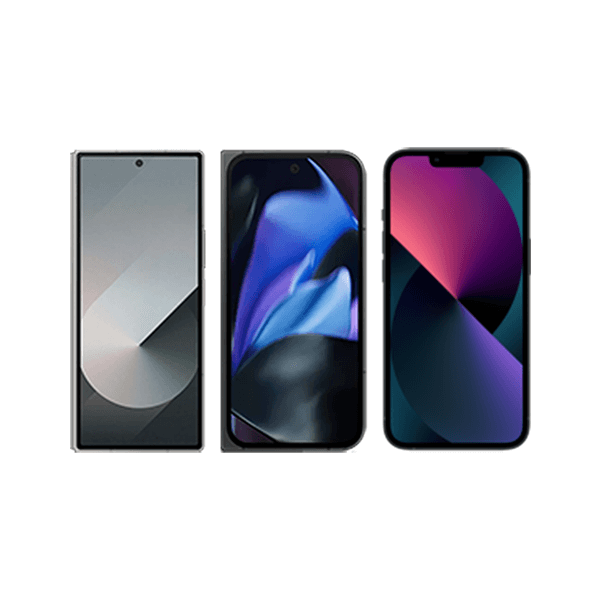How do phone upgrades work? Everything you need to know

Upgrading your mobile phone is the standard way to stay current with the latest performance, security and hardware innovations. It usually involves financing a new mobile phone or buying one outright from your cellular provider or vendor and then transferring your files and settings to the new device.
This article will explore how mobile phone upgrades work, what determines eligibility and the costs to expect so you can upgrade and activate your new smartphone with minimal hassle.
What you'll learn:
- How do phone upgrades work?
- Video: How to Activate And Keep your Current Phone Number
- How to check if your phone is eligible for an upgrade
- How much does it cost to upgrade your phone?
- Can I transfer my upgrade to someone else on my plan?
- Can you cancel a phone contract?
- Conclusion: Simplify your next phone upgrade
- Frequently asked questions
- Looking for more topics?
How do phone upgrades work?
A phone upgrade is the process of replacing an older mobile device with a newer smartphone that offers better performance, updated functionality and new hardware features. You can upgrade by buying a new phone outright or by financing it through your mobile carrier or vendor.
You can pay the full price directly from a vendor or from your wireless provider’s store or pay monthly installments over a one-to two-year contract. Many carriers also offer leasing or phone rental options that give customers access to the latest smartphone models without long-term ownership.
When you upgrade your phone, most carriers give you the option to trade in your old device either at checkout or within a set window later.
The trade-in value applies as credit towards your new smartphone, which lowers the total cost. The old mobile phone must be fully functional and in acceptable condition to qualify.
Mobile carriers also often give a short grace period to test the new device and return it if it doesn’t meet your expectations.
Once you receive your new smartphone, back up your old one, sign in on the new mobile device and transfer your data, apps and settings. Insert your SIM card or set up an eSIM and complete activation with your wireless provider. Many providers, including Astound Mobile, let you complete these steps in their mobile app.
Video tutorial: How to activate and keep your current phone number.
If you buy your phone upfront or already own a compatible device, providers like Astound let you bring your own device (BYOD). The phone must be unlocked, 4G or 5G-ready and compatible with the network. Once you set up your device by signing in with your Google or Apple ID and transferring your files, you can activate your Astound mobile account and subscribe to a cell phone plan to get started.
Once setup is complete, you can return your old device if required by your upgrade agreement.
Build your plan
Your perfect plan is just a click away
Get the speeds, WiFi, mobile and TV plans you need all at an affordable price. Bundle your services with Astound and see how much you can save.

How to check that your phone is eligible for an upgrade
Upgrade eligibility depends on your service provider’s policies and requirements. You can usually confirm eligibility in your online account, in the provider’s mobile app or by contacting your provider’s customer support.
This step confirms whether you can upgrade at that point in your current plan, especially if you are financing your current phone. It often depends on how long you’ve had your phone, how much you’ve paid off and whether your plan accepts early upgrade options.
If you plan to trade in your mobile device, your provider will also check trade-in eligibility. The phone should power on, be in acceptable condition and meet requirements to receive credit toward your new smartphone.
What should I do before sending in my phone for an upgrade? Make sure your mobile device is backed up, reset to factory settings and packaged securely for shipping. Taking these steps to remove personal information before upgrading helps protect your data, prevent delays in the evaluation process and reduce the risk of your device being declared ineligible.
Upgrade timelines vary depending on your wireless provider. Some allow upgrades as early as one month into your plan, while others require you to finish the contract or you’ll have to pay off the remaining balance on your current phone.
Always review your cellular provider’s terms and conditions regarding smartphone upgrades. These terms include any restrictions, warranty policies, upgrade windows or additional payments required. Knowing these details upfront helps ensure a smooth upgrade process.
Switch to Astound Mobile and get up to $2,500!
Switching to an affordable mobile plan is easy with Astound. Sign up for Astound internet + add 2 mobile lines and we’ll pay you up to $500 per phone – up to 5 phones.

How much does it cost to upgrade your phone?
The cost of upgrading your smartphone depends on several factors, including your mobile provider’s terms, the mobile phone model, how you pay and any active promotions or deals available. Some mobile carriers may charge an upgrade fee to cover administrative costs, which is usually added to your next bill or paid at the time of purchase.
A substantial component of the total cost is usually the price of the new mobile device itself. Depending on your budget and preferences, you can pay in full, spread payments over time, lease or rent or reduce the cost with a trade-in program.
Paying in full
You can purchase the phone upfront, either through a vendor or your provider’s store. While paying in full avoids committing to a long-term payment plan and any potential financing restrictions or credit checks, it requires paying a higher amount upfront.
Paying in installments
When you choose to pay in installments, the price of the phone is broken into monthly payments and added to your cellular plan’s cost. For example, a high-end iPhone that costs $1,000 could raise your average cell phone bill by about $42 per month for a two-year contract.
The payment terms also vary by service provider, as most providers offer their own financing options and may require credit checks. Providers like Astound offer financing through a third-party partner for new devices purchased in the Astound shop.
Leasing or renting options
Leasing or renting a mobile device lets you access the latest smartphone models for a set period with a lower upfront price and predictable monthly payments. They also often include extra benefits like maintenance, software updates and technical support.
Trade-in programs
The trade-in value of your old mobile phone can significantly lower the overall cost of the new phone. Value depends on condition, age and market demand. Most providers apply that credit at checkout or shortly after you switch, which makes the new phone more affordable.
Hidden fees to watch for
Are there hidden fees when upgrading a mobile phone? Your wireless provider may charge you upgrade processing charges or early termination penalties. If you’re on a financing plan, you may also have to pay off the balance on your current phone before upgrading. Reviewing your contract terms carefully helps you avoid unnecessary expenses and can help lower your cell phone bill.
When you’re ready to upgrade, check whether your provider offers trade-in programs so you can save money.

Can I transfer my upgrade to someone else on my plan?
The ability to transfer a phone upgrade to someone else on your plan depends on your cell carrier’s policies.
Some carriers provide shared upgrade eligibility within a family or group plan.
In these cases, eligibility for an upgrade is not limited to a specific line. Instead, you can transfer your upgrade to another line on the same plan, allowing them to upgrade their phone. The mobile carrier may require the person receiving the upgrade to accept responsibility for the new phone’s monthly payment obligations or meet other eligibility criteria.
The requirements for shared upgrade eligibility vary depending on the provider. In many cases, the account owner must initiate the transfer, which can only occur between members of the same plan. Providers may also require that the original device be paid off or traded in and be in good working condition.
Other providers tie upgrade eligibility to individual lines, require that a certain percentage of payments be completed or that a specific window of time must pass before a transfer is allowed. In addition, promotional credits or special offers may not always carry over to the receiving line.
Because shared upgrade eligibility varies by provider, always review your contract or financing agreement and check with your service provider to understand the exact rules around transferring an upgrade.
Switching is easy
Switch & Save
Getting started with Astound is easy: just bring your phone or find a new one, pick a plan and add internet.

Can you cancel a phone contract?
You can cancel a phone contract, but you’ll likely have to pay early cancellation fees and other penalties.
Breaking a contract usually has financial implications and the exact price of cancellation depends on your mobile provider’s policies and the contract’s remaining billing period.
Phone contracts generally include early termination fees to recoup the expenses of subsidizing a phone or offering incentives at the contract’s start. These fees are usually specified in the contract’s terms and conditions.
In addition, carriers may impose prorated costs for talk, text and internet data services used before the cancellation date. If your plan involves device financing, you may have to pay the remaining balance on your mobile phone in full to cancel the agreement.
If you cancel your phone contract and would like to upgrade and switch to a new carrier, some carriers run promotions that may cover part or all of your remaining device balance or early termination fees, up to a certain limit.
Before you cancel your phone contract, explore other options your provider has to offer. Some wireless providers give you a short grace period when you first sign up or purchase a new smartphone to test it.
If the mobile phone doesn’t meet your expectations, you can use that window to cancel the contract without penalty.
Other options include transferring the phone contract to another person, placing the plan on temporary hold or negotiating a mutually beneficial arrangement with the wireless provider.
Remember to talk to your carrier’s customer service about contract cancellation. They can review your eligibility, explain any outstanding payment requirements and walk you through the next steps.
Conclusion: Simplify your next phone upgrade
Upgrading your mobile device doesn’t have to be complicated. You can upgrade your phone by either paying for it in full, financing it through your wireless provider or exploring leasing and renting options for temporary ownership. The overall cost of upgrading depends on your provider’s terms, the device model and how you pay, though trade-ins can help lower the total amount and help you save money.
Before sending in your device for an upgrade, confirm its eligibility, backup your data, erase personal information and then mail it safely.
The upgrade policies vary by service provider. Some allow upgrades after a few months into the contract, others require contract completion and some even let you share eligibility to upgrade within a family plan. Most carriers also offer short grace periods to test and return the new device if it doesn’t meet expectations.
Before you decide on upgrading your phone, understand your provider’s policies and evaluate your upgrade options to help you make your transition simple, affordable and hassle-free.
Frequently asked questions
Are there hidden fees when I upgrade my phone?
When you upgrade, your service provider may apply upgrade processing charges, early termination fees or require you to pay the remaining balance on your current smartphone. Checking the terms of your contract ahead of time helps you understand these potential expenses and avoid surprises on your cell phone bill.
What should I do before sending my phone for an upgrade?
Before mailing in your smartphone, back it up, remove your SIM Card or eSIM, reset it to factory settings and package it securely. These steps erase personal data, protect your information and help ensure the evaluation process goes smoothly so your mobile phone isn’t marked ineligible for an upgrade.
Do I need to trade in to upgrade my phone?
No. A trade-in is optional, but its value can significantly reduce the total cost of the new phone. The trade-in value depends on factors like hardware condition, age and market demand. You can still upgrade through financing, leasing or by paying in full without trading in.
When can I upgrade my phone?
Upgrade timelines vary by the wireless provider’s policies. Some let you upgrade a phone just a few months into a contract, while others require you to wait until the contract ends. In most cases you may need to pay off the remaining balance on your current phone before upgrading.
Can I lease or rent a new phone when upgrading?
Yes. Many wireless providers offer leasing or phone rental programs as an alternative to paying full price or getting financing. Customers can use the latest phone models for a period of time with low upfront costs and monthly payments. These plans also include perks like maintenance, software updates and tech support.
Save with Mobile & Internet Together
Get the mobile service, home internet & streaming that’s just right for you.
Astound Mobile requires Astound Internet service. Coverage not available in all areas. A trademark of Ziff Davis, LLC. Used under license. Reprinted with permission. Where available. © 2025 Ziff Davis, LLC. All Rights Reserved. All names, logos, images and service marks are property of their respective owners. ©2025 Radiate Hold Co., LLC d/b/a Astound Broadband. All rights reserved.
This website contains instructional information, including from third-party sources, and is intended, but cannot be guaranteed, to be always up-to-date, complete and accurate. Astound does not endorse, and is not responsible for, any third-party content that may be accessed through this website. Any representation or warranty by Astound that might be otherwise implied by information on this website is expressly disclaimed. Astound expressly disclaims all liability or responsibility with respect to actions taken or not taken based on any or all of the instructional information contained on this website. Astound does not warrant or guarantee the availability of any services at any specific time or geographic location or that services will be provided without interruption. Not all aspects of the Astound services function on all equipment and devices. Use of this website is subject to the Web Site Disclaimer and Web Content Accessibility Policy.

















